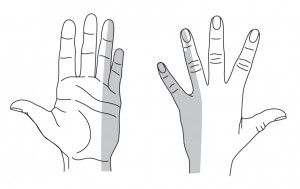Ulnar nerve block
Disclaimer
These guidelines have been produced to guide clinical decision making for the medical, nursing and allied health staff of Perth Children’s Hospital. They are not strict protocols, and they do not replace the judgement of a senior clinician. Clinical common-sense should be applied at all times. These clinical guidelines should never be relied on as a substitute for proper assessment with respect to the particular circumstances of each case and the needs of each patient. Clinicians should also consider the local skill level available and their local area policies before following any guideline.
Read the full CAHS Emergency Department disclaimer.
|

Aim
The guide Perth Children's Hospital (PCH) staff in the use of ulnar nerve block.
Background1,2
An ulnar nerve block uses local anaesthetic to block the nerve at the wrist, allowing procedures on the ulnar side of the hand and in the 5th finger (grey area on diagram).
Pre-procedure
Indications1,2
Suitable for use in injuries requiring procedures on the 5th finger and / or ulnar side of hand (i.e. over the 5th metacarpal) with treatment of duration less than 30-45 minutes such as:
- Finger or hand lacerations requiring suturing
- Manipulation of phalangeal fractures or interphalangeal joint dislocations
- Manipulation of 5th metacarpal fractures.
Requirements
- The patient needs to be able to cooperate with injections and hold still for the procedure intended.
- Formal consent not required but procedure should be clearly documented.
- A clear explanation of the procedure needs to be provided to the patient.
- Risks need to be explained:
- Pain as the injection is made
- Nerve block might not work
- Bruising and bleeding at the site of injection
- Ensure the patient is in the appropriate treatment area.
Preparation
Equipment and dosing
- Sterile gloves and dressing pack with antiseptic (chlorhexidine 2% or similar).
Needle
- 25-gauge bevelled needle (orange) for the injection.
Local anaesthetic
Procedure
- Explain the procedure and its purpose to the carer and patient.
- Consider topical local anaesthetic e.g. lidocaine (lignocaine) 2.5% with prilocaine 2.5% cream (EMLA®) application over injection site.
- Consider nitrous oxide for sedation whilst injections are occurring.
Positioning and technique1,2
- Patient positioned with palm held upwards and slightly flexed with wrist appropriately draped and prepared with aseptic technique
- Identify the flexor carpi ulnaris tendon (the ulnar nerve runs immediately underneath this tendon)
- An injection is made 1-2 cm proximal to the proximal wrist crease with the needle horizontal (i.e. coming from the ulnar side and aiming towards the radius), aiming to infiltrate lidocaine (lignocaine) a few millimetres beneath the carpi ulnaris tendon.
- Aspirate the needle to confirm that it is not in a blood vessel.
- If paraesthesia is felt, then do not inject as this indicates that the needle lies within the nerve and will damage it.
- Calculated dose of lidocaine (lignocaine) is injected slowly and should inject easily if in the right place
- Allow up to 10 minutes for the block to become effective. If the area still has some sensation, a repeat injection can improve the effect (after another 5-10 minutes) up to the maximum dose if not exceeded.
- It may be necessary to inject 2-3 mL of lidocaine (lignocaine) subcutaneously around the ulnar styloid to block the dorsal sensory branch of the nerve which may not have been blocked with the initial injection (branches off just above wrist, so hopefully blocked with first injection).
Documentation
- All medication (including local anaesthetic) must be prescribed on the WA paediatric Hospital Medication Chart (pHMC).
- A procedure note should be entered into the patient medical record.
- It is important to document:
- Pre-procedure pain score
- Side of ulna nerve block
- Use of ultrasound or anatomical landmarks
- Needle type and size
- Local anaesthetic agent and dose
- Immediate complications
- Post nerve block pain scores should be performed and documented in the age-appropriate Observation and Response Tool 30 minutes after the procedure.
References and further reading
- King C, and Henretic F (2008) Textbook of pediatric emergency procedures. Ch 35. Pg 439-468 Philadelphia: Lippincott Williams and Wilkins.
- Roberts J. (2019) Roberts and Hedges’ Clinical Procedures in Emergency Medicine and Acute Care, Seventh Edition. Boston: Elsevier
- Royal Children’s Hospital Melbourne: Lidocaine (lignocaine) | Paediatric Injectable Guidelines Online (health.wa.gov.au). Update 2024. Cited 17 November 2021. Available from: Lidocaine (lignocaine) | Paediatric Injectable Guidelines Online (health.wa.gov.au)
- Australian Medicines Handbook [Internet]. Adelaide: AMH; c2022. Lidocaine. Available from: Lidocaine (anaesthesia) - Australian Medicines Handbook (health.wa.gov.au)
- Lidocaine Hydrochloride BNF for Children. Last Updated: 17 August 2020. Cited: 17 November 2025. Available from: MedicinesComplete — CONTENT > BNF for Children > Drug: Lidocaine hydrochloride (health.wa.gov.au)
- UpToDate: Subcutaneous infiltration of local anesthetics. Update Jan 2024. UpTo Date. Available from: Subcutaneous infiltration of local anesthetics - UpToDate (health.wa.gov.au)
- Dieckmann R, Fiser D, Selbst S. Illustrated Textbook of Pediatric Emergency & Critical Care Procedures St Louis, Mosby, 1997
- Andrade A, Hern HG. Traumatic Hand Injuries: The Emergency Clinician’s Evidence Based Approach.Emergency Medicine Practice. 2011; 13(6)
| Endorsed by: |
CAHS Drug and Therapeutics Committee |
Date: |
Dec 2025 |
This document can be made available in alternative formats on request for people with disability.